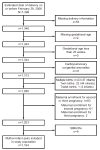Mode of delivery and infant respiratory morbidity among infants born to HIV-1-infected women
- PMID: 20664394
- PMCID: PMC2964131
- DOI: 10.1097/AOG.0b013e3181e8f38a
Mode of delivery and infant respiratory morbidity among infants born to HIV-1-infected women
Abstract
Objective: To estimate risk of infant respiratory morbidity associated with cesarean delivery before labor and ruptured membranes among HIV-1-infected women.
Methods: In a prospective cohort study of HIV-1-infected women and their infants, mode of delivery was determined by clinicians at the participating sites. For this analysis, "elective cesarean delivery" was defined as any cesarean delivery, regardless of gestational age, without labor and with duration of ruptured membranes of less than 5 minutes. Nonelective cesarean deliveries were those performed after the onset of labor, rupture of membranes, or both. Vaginal delivery included normal spontaneous and instrument deliveries. Associations between mode of delivery and infant respiratory morbidity were assessed using chi or Fisher's exact test. Adjusted odds of respiratory distress syndrome by delivery mode were assessed using multivariable logistic regression.
Results: Among 1,194 mother-infant pairs, there were significant differences according to mode of delivery in median gestational age (weeks) at delivery (vaginal, n=566, median=38.8; nonelective cesarean, n=216, median=38.0; and elective cesarean, n=412, median 38.1; P<.001) and incidence of respiratory distress syndrome (vaginal, n=9, 1.6%, reference; nonelective cesarean, n=16, 7.4%; elective cesarean, n=18; 4.4%; (P<.001). In analyses adjusted for gestational age and birth weight, mode of delivery was not statistically significantly associated with infant respiratory distress syndrome (P=.10), although a trend toward an increased risk of respiratory distress syndrome among infants delivered by cesarean was suggested (nonelective cesarean adjusted odds ratio [OR] 2.32, 95% confidence interval [CI] 0.95-5.67; elective cesarean OR 2.56, 95% CI 1.01-6.48).
Conclusion: Respiratory distress syndrome rates associated with elective cesarean delivery among HIV-1-infected women are low, comparable with published rates among uninfected women. There is minimal neonatal respiratory morbidity risk in near-term infants born by elective cesarean delivery to HIV-1-infected women.
Level of evidence: II.
Figures



References
-
- European Mode of Delivery Collaboration. Elective caesarean-section versus vaginal delivery in prevention of vertical HIV-1 transmission: a randomised clinical trial. Lancet. 1999:353–1035. published erratum appears in Lancet 1999;353:1714. - PubMed
-
- The mode of delivery and the risk of vertical transmission of human immunodeficiency virus type 1–a meta-analysis of 15 prospective cohort studies. The International Perinatal HIV Group. N Engl J Med. 1999;340:977–87. - PubMed
-
- American College of Obstetricians and Gynecologists. Scheduled cesarean delivery and the prevention of vertical transmission of HIV infection. ACOG Committee Opinion 234. Int J Gynaecol Obstet. 2001;73:279–81. - PubMed
-
- Public Health Service Task Force. Recommendations for use of antiretroviral drugs in pregnant HIV-1-infected women for maternal health and interventions to reduce perinatal HIV-1 transmission in the United States. 2008. Available at: http://aidsinfo.nih.gov/contentfiles/PerinatalGL.pdf Retrieved January 13, 2009. - PubMed
-
- Dominguez KL, Lindegren ML, D’Almada PJ, Peters VB, Frederick T, Rakusan TA, et al. Increasing trend of Cesarean deliveries in HIV-infected women in the United States from 1994 to 2000. J Acquir Immune Defic Syndr. 2003;33:232–8. - PubMed
Publication types
MeSH terms
Grants and funding
LinkOut - more resources
Full Text Sources
Medical
Research Materials

